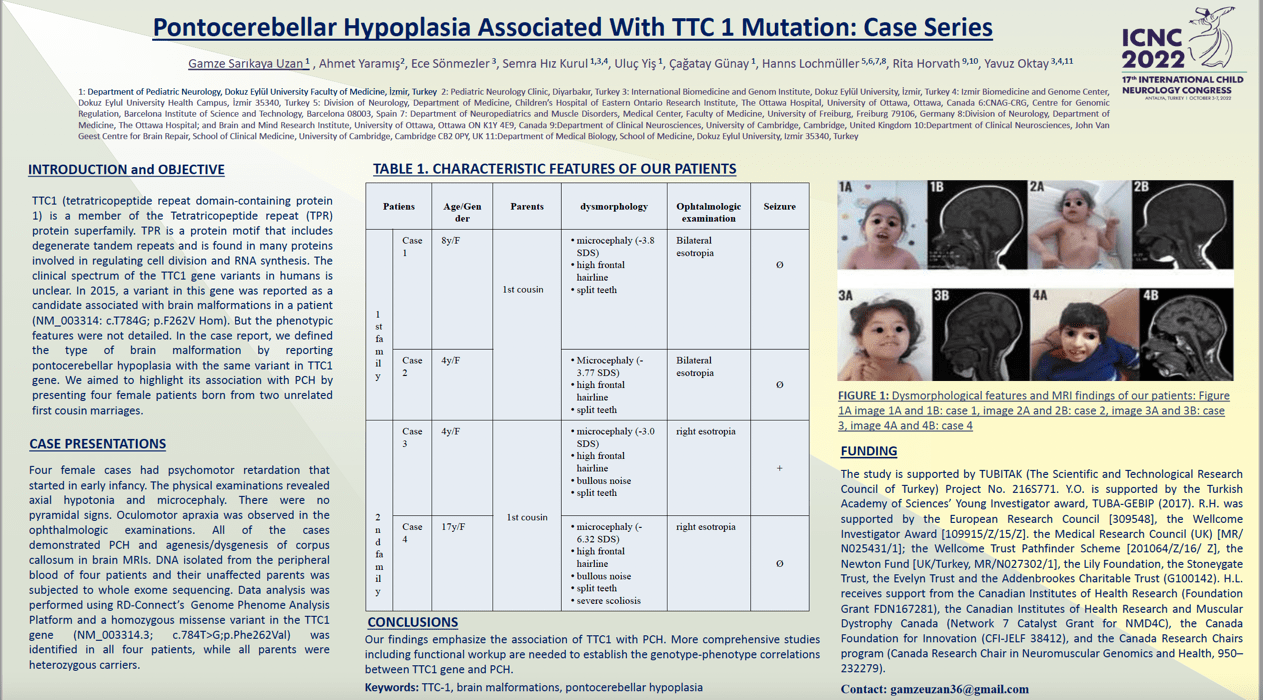Pontocerebellar Hypoplasia Associated With TTC 1 Mutation: Case Series
Gamze Sarıkaya Uzan, Ece Sönmezler, Semra Hız Kurul, Çağatay Günay, Yavuz Oktay, Rita Horvath, Hanns Lochmüller, Uluç Yiş, Ahmet Yaramış
This study is supported by TUBITAK (project no: 216S771). Objective: TTC1 (tetratricopeptide repeat domain-containing protein 1) is a member of the Tetratricopeptide repeat (TPR) protein superfamily. TPR is a protein which degenerates repeating motifs encoded in the genes involved in the regulation of cell division and RNA synthesis. The clinical spectrum of this gene in human is unclear. It was first reported in 2015 as a candidate gene associated with brain malformations in a patient but was not detailed. However, the association of TTC1 with pontocerebellar hypoplasia (PCH) has not been reported. We aimed to highlight its association with PCH by presenting a for female patients born from two different first cousin marriages (two patients from each family). Method: DNA isolation from peripheral blood was performed according to standard protocols and DNA from the four patients and their unaffected parents was subjected to whole exome sequencinq (WES) at the Genomics Platform at the Broad Institute of MIT and Harvard. Data analysis identified a homozygous missense variant in TTC1 gene (c.784T>G; p.Phe262Val). Case Descriptions: Four female cases had psychomotor retardation started in early infancy. The physical examinations revealed axial hypotonia, microcephaly and neuromotor developmental retardation. There were no pyramidal signs. Oculomotor apraxia was observed in the ophthalmologic examinations. All of the cases demostreated PCH and agenetic/disgenetic corpus callosum in brain MRIs. Result: We emphasized the association of TTC1 with PCH. More comprehensive studies including functional work-up are needed to determine the associatin of TTC1 gene with PCH.
Keywords: TTC-1, brain malformations, pontocerebellar hypoplasia
Gamze Sarıkaya Uzan
Dokuz Eylül University Faculty of Medicine
Turkey
Ece Sönmezler
International Biomedicine and Genom Institute, Dokuz Eylül University, İzmir, Turkey
Turkey
Semra Hız Kurul
Division of Child Neurology, Department of Pediatrics, Dokuz Eylül University Faculty of Medicine, İzmir, Turkey
Turkey
Çağatay Günay
Division of Child Neurology, Department of Pediatrics, Dokuz Eylül University Faculty of Medicine, İzmir, Turkey
Turkey
Yavuz Oktay
International Biomedicine and Genom Institute, Dokuz Eylül University, İzmir, Turkey
Turkey
Rita Horvath
Department of Clinical Neurosciences, University of Cambridge, Cambridge, United Kingdom
United Kingdom
Hanns Lochmüller
Division of Neurology, Department of Medicine, Children's Hospital of Eastern Ontario Research Institute, The Ottawa Hospital, University of Ottawa
Canada
Uluç Yiş
Division of Child Neurology, Department of Pediatrics, Dokuz Eylül University Faculty of Medicine, İzmir, Turkey
Ahmet Yaramış
Pediatric Neurology Clinic, Diyarbakır, Turkey
Turkey
This study is supported by TUBITAK (project no: 216S771). Objective: TTC1 (tetratricopeptide repeat domain-containing protein 1) is a member of the Tetratricopeptide repeat (TPR) protein superfamily. TPR is a protein which degenerates repeating motifs encoded in the genes involved in the regulation of cell division and RNA synthesis. The clinical spectrum of this gene in human is unclear. It was first reported in 2015 as a candidate gene associated with brain malformations in a patient but was not detailed. However, the association of TTC1 with pontocerebellar hypoplasia (PCH) has not been reported. We aimed to highlight its association with PCH by presenting a for female patients born from two different first cousin marriages (two patients from each family). Method: DNA isolation from peripheral blood was performed according to standard protocols and DNA from the four patients and their unaffected parents was subjected to whole exome sequencinq (WES) at the Genomics Platform at the Broad Institute of MIT and Harvard. Data analysis identified a homozygous missense variant in TTC1 gene (c.784T>G; p.Phe262Val). Case Descriptions: Four female cases had psychomotor retardation started in early infancy. The physical examinations revealed axial hypotonia, microcephaly and neuromotor developmental retardation. There were no pyramidal signs. Oculomotor apraxia was observed in the ophthalmologic examinations. All of the cases demostreated PCH and agenetic/disgenetic corpus callosum in brain MRIs. Result: We emphasized the association of TTC1 with PCH. More comprehensive studies including functional work-up are needed to determine the associatin of TTC1 gene with PCH.
Keywords: TTC-1, brain malformations, pontocerebellar hypoplasia
Gamze Sarıkaya Uzan
Dokuz Eylül University Faculty of Medicine
Turkey
Ece Sönmezler
International Biomedicine and Genom Institute, Dokuz Eylül University, İzmir, Turkey
Turkey
Semra Hız Kurul
Division of Child Neurology, Department of Pediatrics, Dokuz Eylül University Faculty of Medicine, İzmir, Turkey
Turkey
Çağatay Günay
Division of Child Neurology, Department of Pediatrics, Dokuz Eylül University Faculty of Medicine, İzmir, Turkey
Turkey
Yavuz Oktay
International Biomedicine and Genom Institute, Dokuz Eylül University, İzmir, Turkey
Turkey
Rita Horvath
Department of Clinical Neurosciences, University of Cambridge, Cambridge, United Kingdom
United Kingdom
Hanns Lochmüller
Division of Neurology, Department of Medicine, Children's Hospital of Eastern Ontario Research Institute, The Ottawa Hospital, University of Ottawa
Canada
Uluç Yiş
Division of Child Neurology, Department of Pediatrics, Dokuz Eylül University Faculty of Medicine, İzmir, Turkey
Ahmet Yaramış
Pediatric Neurology Clinic, Diyarbakır, Turkey
Turkey

Gamze Sarıkaya Uzan
Dokuz Eylül University Faculty of Medicine Turkey
Dokuz Eylül University Faculty of Medicine Turkey